Abstract
The toxicology of synthetic chemicals is compared to that of natural chemicals, which represent the vast bulk of the chemicals to which humans are exposed. It is argued that animals have a broad array of inducible general defenses to combat the changing array of toxic chemicals in plant food (nature's pesticides) and that these defenses are effective against both natural and synthetic toxins. Synthetic toxins such as dioxin are compared to natural chemicals, such as indole carbinol (in broccoli) and ethanol. Trade-offs between synthetic and natural pesticides are discussed. The finding that in high-dose tests, a high proportion of both natural and synthetic chemicals are carcinogens, mutagens, teratogens, and clastogens (30-50% for each group) undermines current regulatory efforts to protect public health from synthetic chemicals based on these tests.
Full text
PDF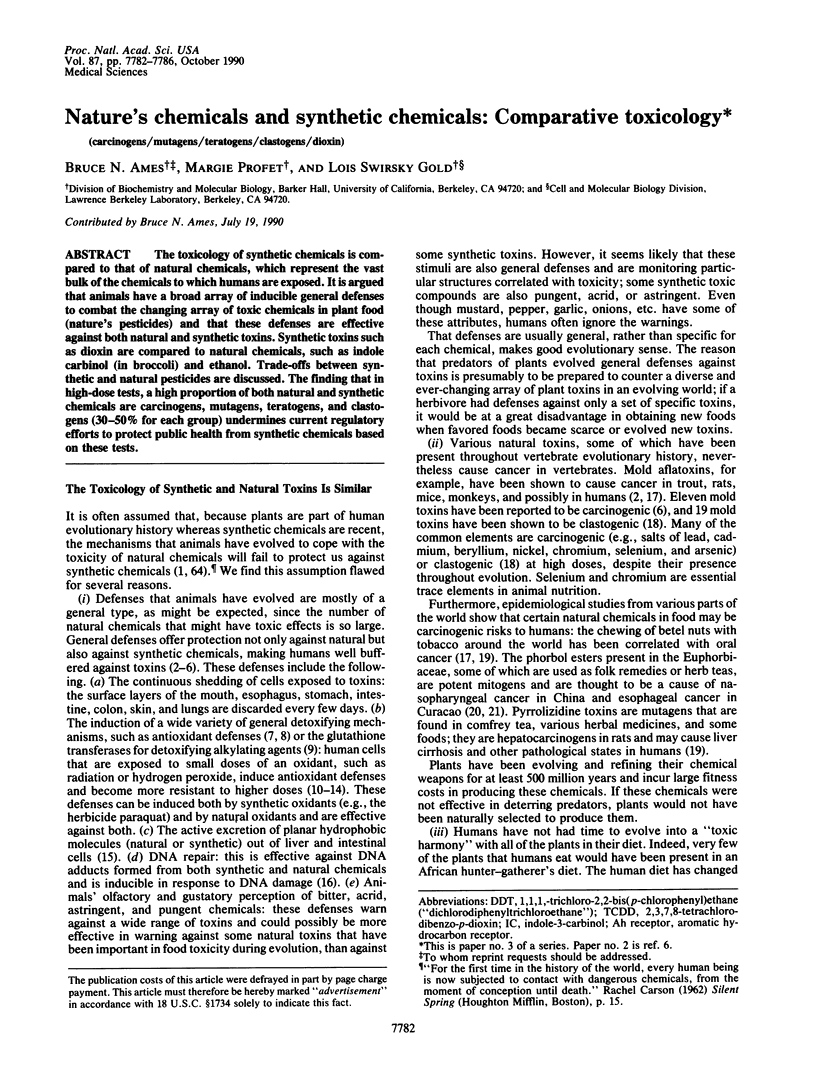
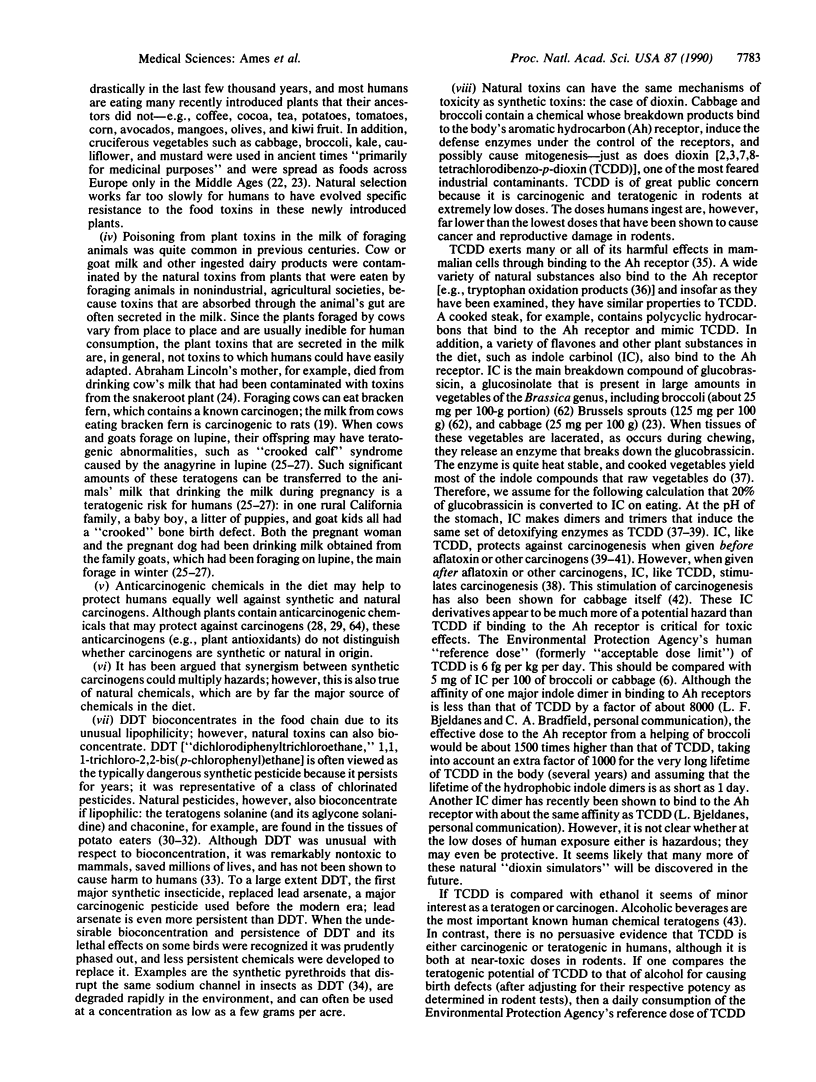
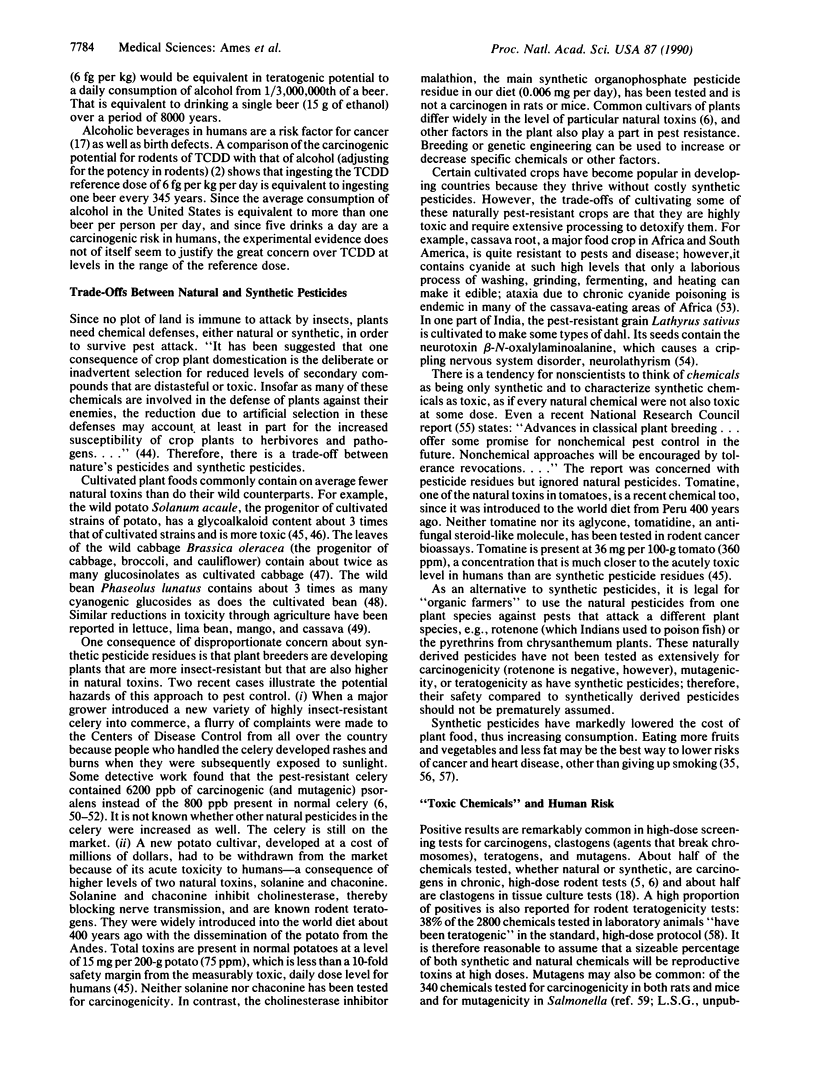
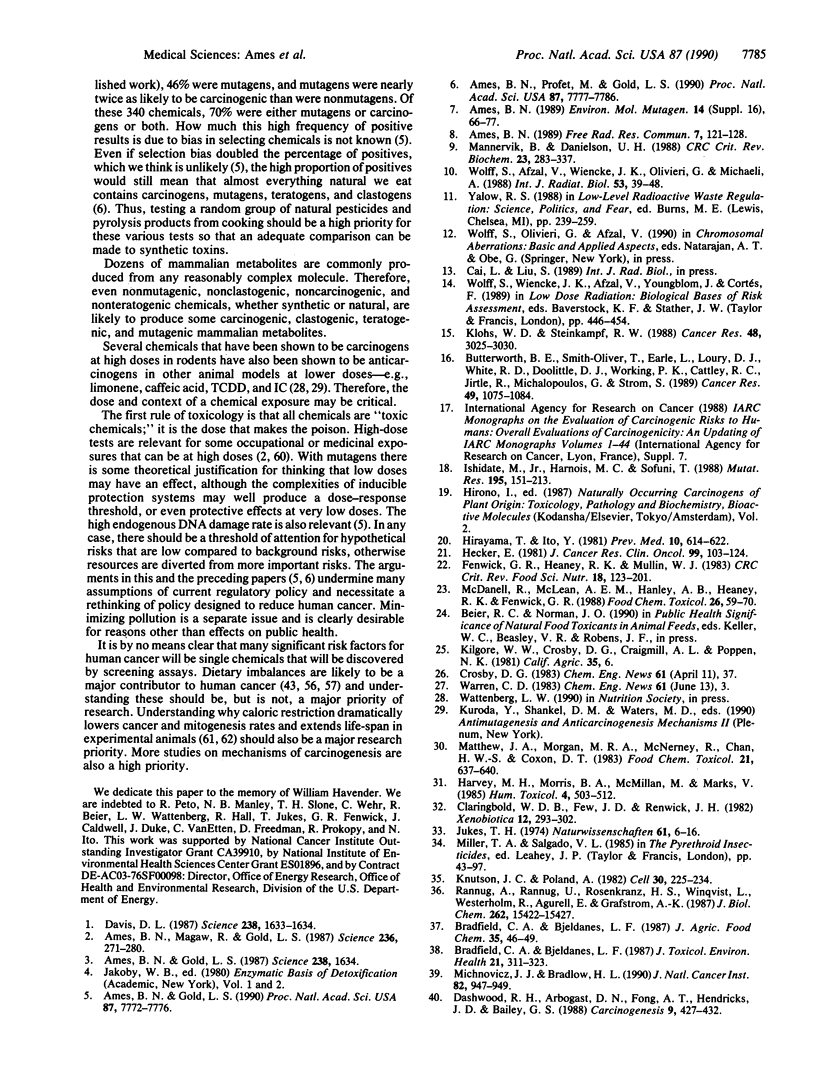
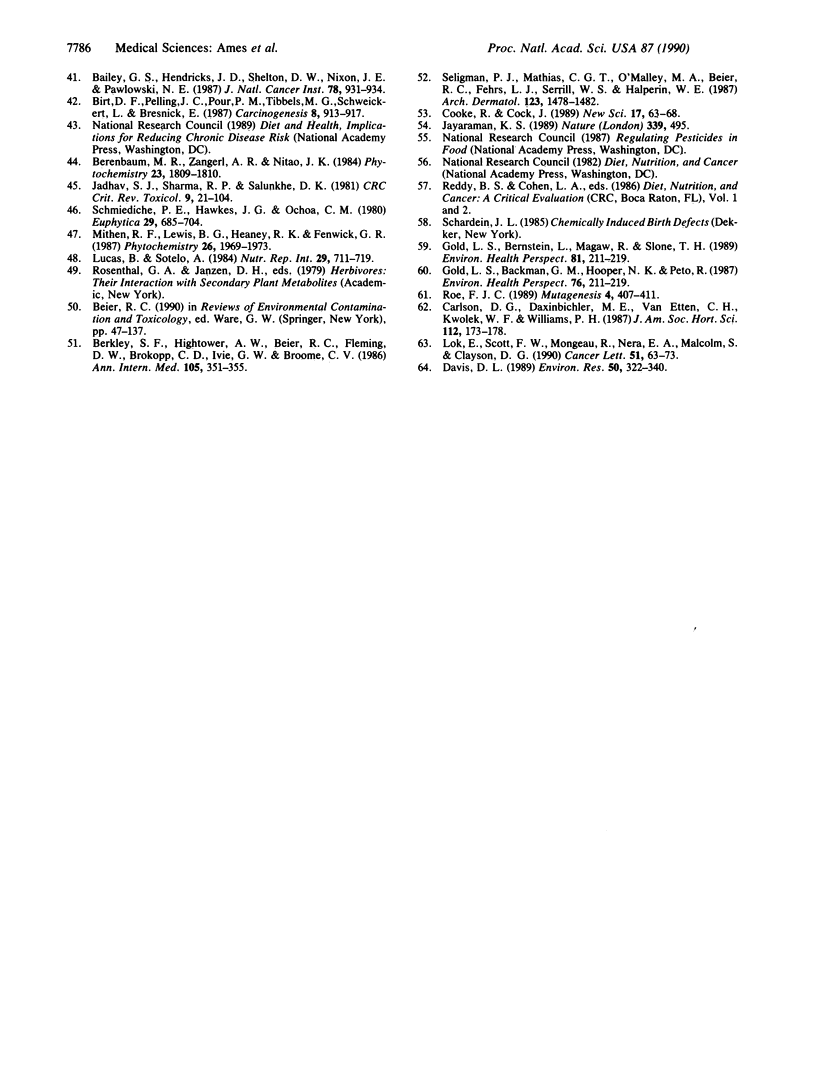
Selected References
These references are in PubMed. This may not be the complete list of references from this article.
- Ames B. N. Endogenous oxidative DNA damage, aging, and cancer. Free Radic Res Commun. 1989;7(3-6):121–128. doi: 10.3109/10715768909087933. [DOI] [PubMed] [Google Scholar]
- Ames B. N., Gold L. S. Chemical carcinogenesis: too many rodent carcinogens. Proc Natl Acad Sci U S A. 1990 Oct;87(19):7772–7776. doi: 10.1073/pnas.87.19.7772. [DOI] [PMC free article] [PubMed] [Google Scholar]
- Ames B. N., Gold L. S. Response: paleolithic diet, evolution, and carcinogens. Science. 1987 Dec 18;238(4834):1634–1634. doi: 10.1126/science.238.4834.1634. [DOI] [PubMed] [Google Scholar]
- Ames B. N., Magaw R., Gold L. S. Ranking possible carcinogenic hazards. Science. 1987 Apr 17;236(4799):271–280. doi: 10.1126/science.3563506. [DOI] [PubMed] [Google Scholar]
- Ames B. N. Mutagenesis and carcinogenesis: endogenous and exogenous factors. Environ Mol Mutagen. 1989;14 (Suppl 16):66–77. doi: 10.1002/em.2850140614. [DOI] [PubMed] [Google Scholar]
- Bailey G. S., Hendricks J. D., Shelton D. W., Nixon J. E., Pawlowski N. E. Enhancement of carcinogenesis by the natural anticarcinogen indole-3-carbinol. J Natl Cancer Inst. 1987 May;78(5):931–934. [PubMed] [Google Scholar]
- Berkley S. F., Hightower A. W., Beier R. C., Fleming D. W., Brokopp C. D., Ivie G. W., Broome C. V. Dermatitis in grocery workers associated with high natural concentrations of furanocoumarins in celery. Ann Intern Med. 1986 Sep;105(3):351–355. doi: 10.7326/0003-4819-105-3-351. [DOI] [PubMed] [Google Scholar]
- Birt D. F., Pelling J. C., Pour P. M., Tibbels M. G., Schweickert L., Bresnick E. Enhanced pancreatic and skin tumorigenesis in cabbage-fed hamsters and mice. Carcinogenesis. 1987 Jul;8(7):913–917. doi: 10.1093/carcin/8.7.913. [DOI] [PubMed] [Google Scholar]
- Bradfield C. A., Bjeldanes L. F. Structure-activity relationships of dietary indoles: a proposed mechanism of action as modifiers of xenobiotic metabolism. J Toxicol Environ Health. 1987;21(3):311–323. doi: 10.1080/15287398709531021. [DOI] [PubMed] [Google Scholar]
- Butterworth B. E., Smith-Oliver T., Earle L., Loury D. J., White R. D., Doolittle D. J., Working P. K., Cattley R. C., Jirtle R., Michalopoulos G. Use of primary cultures of human hepatocytes in toxicology studies. Cancer Res. 1989 Mar 1;49(5):1075–1084. [PubMed] [Google Scholar]
- Claringbold W. D., Few J. D., Renwick J. H. Kinetics and retention of solanidine in man. Xenobiotica. 1982 May;12(5):293–302. doi: 10.3109/00498258209052469. [DOI] [PubMed] [Google Scholar]
- Dashwood R. H., Arbogast D. N., Fong A. T., Hendricks J. D., Bailey G. S. Mechanisms of anti-carcinogenesis by indole-3-carbinol: detailed in vivo DNA binding dose-response studies after dietary administration with aflatoxin B1. Carcinogenesis. 1988 Mar;9(3):427–432. doi: 10.1093/carcin/9.3.427. [DOI] [PubMed] [Google Scholar]
- Davis D. L. Natural anticarcinogens, carcinogens, and changing patterns in cancer: some speculation. Environ Res. 1989 Dec;50(2):322–340. doi: 10.1016/s0013-9351(89)80013-1. [DOI] [PubMed] [Google Scholar]
- Davis D. L. Paleolithic diet, evolution, and carcinogens. Science. 1987 Dec 18;238(4834):1633–1634. doi: 10.1126/science.3120316. [DOI] [PubMed] [Google Scholar]
- Fenwick G. R., Heaney R. K., Mullin W. J. Glucosinolates and their breakdown products in food and food plants. Crit Rev Food Sci Nutr. 1983;18(2):123–201. doi: 10.1080/10408398209527361. [DOI] [PubMed] [Google Scholar]
- Gold L. S., Backman G. M., Hooper N. K., Peto R. Ranking the potential carcinogenic hazards to workers from exposures to chemicals that are tumorigenic in rodents. Environ Health Perspect. 1987 Dec;76:211–219. doi: 10.1289/ehp.8776211. [DOI] [PMC free article] [PubMed] [Google Scholar]
- Gold L. S., Bernstein L., Magaw R., Slone T. H. Interspecies extrapolation in carcinogenesis: prediction between rats and mice. Environ Health Perspect. 1989 May;81:211–219. doi: 10.1289/ehp.8981211. [DOI] [PMC free article] [PubMed] [Google Scholar]
- Harvey M. H., Morris B. A., McMillan M., Marks V. Measurement of potato steroidal alkaloids in human serum and saliva by radioimmunoassay. Hum Toxicol. 1985 Sep;4(5):503–512. doi: 10.1177/096032718500400506. [DOI] [PubMed] [Google Scholar]
- Hecker E. Cocarcinogenesis and tumor promoters of the diterpene ester type as possible carcinogenic risk factors. J Cancer Res Clin Oncol. 1981;99(1-2):103–124. doi: 10.1007/BF00412447. [DOI] [PMC free article] [PubMed] [Google Scholar]
- Hirayama T., Ito Y. A new view of the etiology of nasopharyngeal carcinoma. Prev Med. 1981 Sep;10(5):614–622. doi: 10.1016/0091-7435(81)90051-7. [DOI] [PubMed] [Google Scholar]
- Ishidate M., Jr, Harnois M. C., Sofuni T. A comparative analysis of data on the clastogenicity of 951 chemical substances tested in mammalian cell cultures. Mutat Res. 1988 Mar;195(2):151–213. doi: 10.1016/0165-1110(88)90023-1. [DOI] [PubMed] [Google Scholar]
- Jadhav S. J., Sharma R. P., Salunkhe D. K. Naturally occurring toxic alkaloids in foods. Crit Rev Toxicol. 1981 Apr;9(1):21–104. doi: 10.3109/10408448109059562. [DOI] [PubMed] [Google Scholar]
- Jayaraman K. S. Neurolathyrism remains a threat in India. Nature. 1989 Jun 15;339(6225):495–495. doi: 10.1038/339495d0. [DOI] [PubMed] [Google Scholar]
- Jukes T. H. Insecticides in health, agriculture and the environment. Naturwissenschaften. 1974 Jan;61(1):6–16. doi: 10.1007/BF00602886. [DOI] [PubMed] [Google Scholar]
- Klohs W. D., Steinkampf R. W. Possible link between the intrinsic drug resistance of colon tumors and a detoxification mechanism of intestinal cells. Cancer Res. 1988 Jun 1;48(11):3025–3030. [PubMed] [Google Scholar]
- Knutson J. C., Poland A. Response of murine epidermis to 2,3,7,8-tetrachlorodibenzo-p-dioxin: interaction of the ah and hr loci. Cell. 1982 Aug;30(1):225–234. doi: 10.1016/0092-8674(82)90028-9. [DOI] [PubMed] [Google Scholar]
- Lok E., Scott F. W., Mongeau R., Nera E. A., Malcolm S., Clayson D. B. Calorie restriction and cellular proliferation in various tissues of the female Swiss Webster mouse. Cancer Lett. 1990 May 15;51(1):67–73. doi: 10.1016/0304-3835(90)90232-m. [DOI] [PubMed] [Google Scholar]
- Mannervik B., Danielson U. H. Glutathione transferases--structure and catalytic activity. CRC Crit Rev Biochem. 1988;23(3):283–337. doi: 10.3109/10409238809088226. [DOI] [PubMed] [Google Scholar]
- Matthew J. A., Morgan M. R., McNerney R., Chan H. W., Coxon D. T. Determination of solanidine in human plasma by radioimmunoassay. Food Chem Toxicol. 1983 Oct;21(5):637–640. doi: 10.1016/0278-6915(83)90152-7. [DOI] [PubMed] [Google Scholar]
- McDanell R., McLean A. E., Hanley A. B., Heaney R. K., Fenwick G. R. Chemical and biological properties of indole glucosinolates (glucobrassicins): a review. Food Chem Toxicol. 1988 Jan;26(1):59–70. doi: 10.1016/0278-6915(88)90042-7. [DOI] [PubMed] [Google Scholar]
- Michnovicz J. J., Bradlow H. L. Induction of estradiol metabolism by dietary indole-3-carbinol in humans. J Natl Cancer Inst. 1990 Jun 6;82(11):947–949. doi: 10.1093/jnci/82.11.947. [DOI] [PubMed] [Google Scholar]
- Rannug A., Rannug U., Rosenkranz H. S., Winqvist L., Westerholm R., Agurell E., Grafström A. K. Certain photooxidized derivatives of tryptophan bind with very high affinity to the Ah receptor and are likely to be endogenous signal substances. J Biol Chem. 1987 Nov 15;262(32):15422–15427. [PubMed] [Google Scholar]
- Roe F. J. Non-genotoxic carcinogenesis: implications for testing and extrapolation to man. Mutagenesis. 1989 Nov;4(6):407–411. doi: 10.1093/mutage/4.6.407. [DOI] [PubMed] [Google Scholar]
- Seligman P. J., Mathias C. G., O'Malley M. A., Beier R. C., Fehrs L. J., Serrill W. S., Halperin W. E. Phytophotodermatitis from celery among grocery store workers. Arch Dermatol. 1987 Nov;123(11):1478–1482. [PubMed] [Google Scholar]
- Wolff S., Afzal V., Wiencke J. K., Olivieri G., Michaeli A. Human lymphocytes exposed to low doses of ionizing radiations become refractory to high doses of radiation as well as to chemical mutagens that induce double-strand breaks in DNA. Int J Radiat Biol Relat Stud Phys Chem Med. 1988 Jan;53(1):39–47. doi: 10.1080/09553008814550401. [DOI] [PubMed] [Google Scholar]


